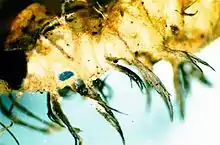Rhizine
In lichens, rhizines are multicellular root-like structures, arising mostly from the lower surface. A lichen with rhizines is termed rhizinate, while a lichen lacking rhizines is termed erhizinate. Rhizines serve only to anchor the lichen to their substrate; they do not absorb nutrients as do plant roots. Characteristics of the rhizines are used to identify lichens, for example: whether they are dense or sparse, whether they are uniformly distributed or clumped in specific areas, and whether they are straight or branched. Only foliose lichens may possess rhizines, not crustose or fruticose lichens, which lack a lower cortex.[1]

Rhizohyphae are a type of attachment structure on some lichens. Rhizohyphae are more slender than rhizines and are one cell thick in diameter. Rhizohyphae often occur as a felt-like hyphal mass.[2]
See also
References
- McCune, Bruce, and Linda Geiser. Macrolichens of the Pacific northwest. OSU Press, 1997.
- McCune, Bruce; Linda Geiser; Sylvia Duran Sharnoff; Stephen Sharnoff (2009). Macrolichens of the Pacific Northwest. Illustration by Alexander G. Mikulin (2nd ed.). Corvallis: Oregon State University Press. p. 448. ISBN 978-0870715655.